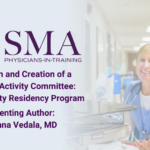Abstract | May 5, 2021
Inception and Creation of a Scholarly Activity Committee: A Community Residency Program
Learning Objectives
- Upon completion of this lecture, learners should be better prepared to identify means of improving scholarly activity among community residency programs.
Introduction
The Accreditation Council for Graduate Medical Education (ACGME) has established guidelines requiring specific standards for scholarly activity in post-graduate medical education accreditation. Being unable to meet these standards is often a common citation by Residency Review Committee. Devoting more financial resources has been shown to improve compliance and avoid punishment. However, establishing a structured scholarly activity program has also been shown to be beneficial. Community residency programs often present with more barriers to conducting scholarly activity than academic center residency programs. Here, we discuss the significant improvements made from establishing a scholarly activity committee (SAC) at our institution.
Methods/Results
Since inception of our residency program in 2017, we have successfully met ACGME scholarly activity requirements. Over the past three years, our achievements included twelve publications, four awards, four QI projects and at least fifteen abstract presentations at national conferences. However, we felt our potential could be greater and that we also lacked the necessary infrastructure for greater variety of projects. We initiated the SAC in June 2020 composed of three upper level residents with extensive research experience. In the 6 months since SAC formation, we have approximately nineteen publications, four awards, six QI projects and twelve abstract presentations. In coordination with program administration, we have devoted greater financial resources for resident-led research. We also started a resident-led community health literacy project with the local newspaper on a biweekly basis yielding twelve articles already. SAC also partnered with our IT department and created a data abstraction request form, enabling greater number of chart reviews and retrospective studies. In addition, we enhanced access to Microsoft Office and a reference managing software. SAC also revised the program awards structure in order to recognize more residents and to encourage more scholarly activity and professionalism.
Conclusion
In conclusion, our institution has showed the benefit of creating a SAC in order to enhance scholarly activity. Our results over the past six months have been quite remarkable. Our hope for the future is to continue improving our infrastructure, supporting more complex projects and increasing research coordination with other local institutions.

